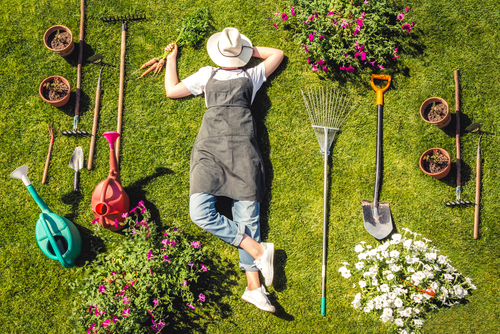“To till or not to till?” That is the question we’ll be digging into (pun intended) as we explore the impact of manual versus motorized gardening on your body.
Get ready to unearth the pros and cons of each approach and discover which one will help you cultivate not just a healthy garden, but a healthy body too.
Manual Gardening
Manual gardening is the original and traditional form of gardening, and it has stood the test of time for good reason.
The Pros
- Great Workout. One of the biggest benefits of manual gardening is that it’s a great workout. All that digging, raking, and planting can help you build strength and improve your flexibility. Plus, it’s a fun way to get your heart rate up without having to hit the gym.
- Improves Mental Health. Another advantage of manual gardening is that it can help reduce stress and improve your mental health. Spending time outside in the fresh air and sunshine can be a great mood booster, and there’s something therapeutic about getting your hands dirty and working with plants.
- Cost-Effective. Manual gardening is often more cost-effective than using motorized tools, as it requires minimal equipment and can be done with basic hand tools.
- Environmental Benefits. Manual gardening is a more sustainable option as it does not require electricity or fuel to operate. It also allows for greater precision and control when working with delicate plants.
- Creative Expression. It also allows for more creativity and personal expression, as it allows for greater hands-on control over the design and care of your garden. It can also be a fun way to bond with family and friends by involving them in the gardening process.
The Cons
- Aches and Pains. As with any physical activity, manual gardening can come with its share of aches and pains. All that bending, lifting, and repetitive motion can lead to strain and injury, especially if you’re not using the proper technique or equipment.
- Time and Effort. Manual gardening can also be more time-consuming and labour-intensive than using motorized tools. If you have a large garden, it can take hours of work to get everything done.
- Limitations. It can have limitations based on individual physical abilities. For example, individuals with arthritis or osteoporosis may find manual gardening too physically demanding, making motorized gardening a more suitable option.
Motorized Gardening
While it may seem like an easier option, there are both advantages and disadvantages to using machines in your gardening endeavours.

The Pros
- The Need for Speed. One of the biggest benefits of motorized gardening is its efficiency. With the help of machines like tillers and lawnmowers, you can cover more ground in less time.
- Less Strain on the Body. Another advantage of motorized gardening is that it can reduce physical strain and the risk of injury. By using machines to do the heavy lifting, you can avoid the aches and pains that can come with manual gardening.
- Consistency and Precision. Motorized gardening tools allow for greater consistency and precision in garden maintenance tasks such as mowing and trimming. This can result in a more uniform and aesthetically pleasing garden.
- Access to Hard-to-Reach Areas. Motorized gardening tools such as hedge trimmers and chainsaws can allow you to reach and maintain hard-to-reach areas, such as high hedges or tree branches.
The Cons
- Where’s the Workout? One major downside is that it doesn’t provide the same level of physical activity as manual gardening. Without the need to manually dig, rake, and hoe, you may miss out on the exercise benefits that come with these tasks.
- The Sound of Silence. Another potential drawback of motorized gardening is the noise pollution. Machines like lawnmowers and leaf blowers can be loud and disruptive to both your own peace and quiet, as well as your neighbors’.
- Cost. Motorized gardening tools can be expensive to purchase and maintain, especially if you opt for higher-end models. This can be a significant investment for those on a budget.
- Environmental Impact. Gas-powered machines produce emissions that contribute to air pollution, while electric machines require energy to operate. In addition, motorized gardening can disrupt natural habitats and ecosystems, such as disturbing insect and bird populations.
Osteopathy and Gardening
Gardening is a popular pastime enjoyed by people of all ages and backgrounds. While it is a relaxing and enjoyable hobby, it can also have a significant impact on our overall health and well-being, particularly for individuals who suffer from conditions such as arthritis or osteoporosis.
Osteopathy, a form of alternative medicine that focuses on the musculoskeletal system, can play an important role in helping individuals manage their conditions and maintain their physical health while gardening.
One of the key benefits of gardening for osteopathic health is the opportunity to engage in low-impact exercise.
Activities such as digging, planting, and weeding can help to improve joint flexibility and mobility, reduce inflammation, and increase bone density. For individuals with arthritis, gentle movements such as these can also help to alleviate stiffness and pain in the joints.

Gardening Strategies for Individuals with Arthritis or Osteoporosis
Individuals with conditions such as arthritis or osteoporosis may face physical limitations when it comes to gardening. However, there are strategies that can be employed to reduce strain on the body and allow for an enjoyable and fulfilling gardening experience.
One effective strategy is the use of raised garden beds. By elevating the garden bed, individuals can minimize the need for bending and kneeling, reducing strain on the back, knees, and hips. Additionally, using knee pads or a gardening stool can help to further reduce pressure on the joints.
Osteopathic practitioners can also play a role in helping individuals with arthritis or osteoporosis develop personalized gardening strategies.
An osteopath can provide guidance on proper body mechanics, stretching and strengthening exercises, and other techniques to help reduce the risk of injury and discomfort.
Incorporating these strategies can allow individuals with arthritis or osteoporosis to continue to enjoy the physical and mental benefits of gardening while minimizing the risk of pain or injury.
Closing Thoughts
So, whether you’re a seasoned gardener or just starting out, take some time to evaluate your gardening habits and make any necessary adjustments to support your osteopathic health. After all, a healthy body is the best tool for a bountiful garden.
Fresh Pasta and Sauce Delivered To Your Door





